"Victorian Fat Shaming: Harsh Words on Weight from the Nineteenth Century" by Mimi Matthews2/9/2017 Mimi Matthews writes both non-fiction history and traditional historical romances set in 19th century England. She is a member of Romance Writers of America, The Beau Monde, Savvy Authors, and English Historical Fiction Authors, and is currently represented by Serendipity Literary Agency in New York. Her articles on 19th century romance, literature, and history have been published on various academic and history sites, including the Victorian Web, and are also syndicated weekly at Bust Magazine. In her other life, Mimi is an attorney with both a Juris Doctor and a Bachelor of Arts in English Literature. She resides in California with her family – which includes an Andalusian dressage horse, a Sheltie, and two Siamese cats. You can follow her at @MimiMatthewsEsq. “All defects are in the nature of ugliness, but certain ones are more degrading than others; and of these obesity, which is a deformity, is signally ignoble.” - The Woman Beautiful, 1899. During the early and mid-Victorian era, a great many health and beauty books echoed the popular 19th century sentiment that plumpness equaled good health. It was leanness, not heaviness, to which beauty experts directed the majority of their criticism. For example, in his 1870 book Personal Beauty: How to Cultivate and Preserve it in Accordance with the Laws of Health, author Daniel Brinton states that a “scrawny bony figure” is “intolerable to gods and men.” According to Brinton, the only occasion on which excessive leanness had ever been beneficial to a lady was in an encounter with a cannibal. As he explains: 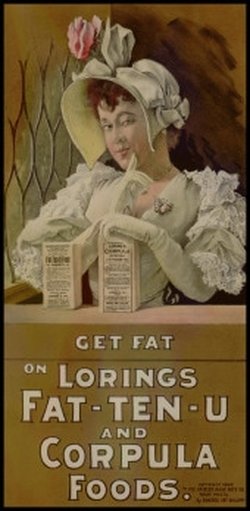 Lorings Advert, 1896. Lorings Advert, 1896. “The only lady who we ever heard derived advantage from such an appearance was Madame Ida Pfeiffer. She relates that somewhere in her African travels the natives had a mind to kill and eat her, but she looked so unpalatably lean and tough that the temptation was not strong enough, and thus her life was saved.” This did not mean that there were no diets or patent nostrums for reducing weight. Quite the contrary. For the morbidly obese, Brinton himself lays out an entire regime based on the popular 19th century belief that fat was “only water” and could be driven out of the system by perspiration. But though Brinton and other health and beauty authors of the Victorian era generally took a sympathetic tone toward the very overweight, by the end of the century a new trend was on the rise. No longer was roundness or plumpness seen as being wholly synonymous with health and beauty. Instead, many Victorians began to view excess weight as a sign that a woman was inconsiderate, stupid, lazy, and—in some cases—even promiscuous or insane. In his 1897 book, The Female Offender, author Cesare Lombroso makes the connection between obesity and prostitution. Using extraordinarily detailed graphs and tables, he compares the weights and measurements of overweight prostitutes with those of slimmer, “moral” women. He concludes that obesity is directly linked to promiscuity and uncivilized behavior, writing: “This greater weight among prostitutes is confirmed by the notorious fact of the obesity of those who grow old in their vile trade, and who gradually become positive monsters of adipose tissue.” Taking his research a step further, Lombroso looks at the weights and measurements of women who have been committed to insane asylums, writing: “In conclusion, I would remark that in prisons and asylums for the insane, the female lunatics are far more often exaggeratedly fat than the men.” This belief that obesity was linked to sexuality, promiscuity, and mental derangement was only one facet of what—for lack of a better word—I will call Victorian fat shaming. More common still was the view that the overweight were selfish or inconsiderate in some way. A particularly harsh example of this comes from the 1899 book The Woman Beautiful, in which author Adelia Fletcher excoriates overweight women for their selfishness, writing: “Wherever the fat woman finds herself in a crowd—and where can she avoid it in the metropolis?—she is in effect an intruder. For, she occupies twice the space to which she is entitled, and inflicts upon her companions, through every one of her excessive pounds, just so much additional fatigue and discomfort. Too often, this so redundant flesh seems to serve as a. bullet-proof armor, repelling all consciousness of the rights of others. The woman who makes a god of her stomach is incorrigible, and I fear no word of mine will avail to induce her to reform. She is the innately selfish woman who makes her very existence an offense.” 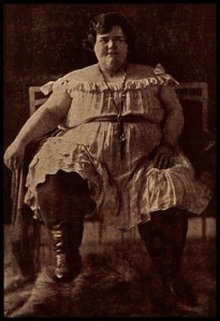 At one point in her lengthy attack against overweight women, Fletcher acknowledges that “corpulency” is a disease. However, this does not stop her from attributing excess weight to a woman’s “indolence of mind” and categorizing overeaters as a lower order of beast. The Victorian idea that obesity was incompatible with intelligence and mental acuity was a common one. As a 1900 edition of the Dietetic and Hygienic Gazette reports:“Obesity always carries with it physical and often mental weakness…” This stereotype was frequently enforced by overweight characters in popular plays and novels who were portrayed as dimwitted and lazy. An 1893 edition of Charles Dickens’ weekly literary magazine All the Year Round addresses this, stating: “People have rather an erroneous idea, probably gathered from Dickens’s Fat Boy in ‘Pickwick,’ that corpulent people have none of the finer feelings and are of a lethargic and dull comprehension. This is altogether a mistake, as many a poor corpulent lady can tell you. When she ascends a crowded omnibus on a hot summer’s day every one of the indignant glances levelled at her by her more fortunate sisters are as so many little dagger thrusts of mortification, though her ruddy complexion and defiant stentorian breathing may seem to belie the truth of these words.” The increased attacks against obesity in the late Victorian era were just one part of an overall “clean living movement.” Temperance reformers levied similar charges against those who used alcohol and tobacco. According to the 2012 book Alcohol, Tobacco, and Obesity, just as temperance reformers viewed alcohol as “the root of social, moral, and physical decay” and linked tobacco to “the corruption of innocence,” so too was obesity given a moral dimension. As the book explains: “Clearly, although the strength of these three reform movements and the personnel involved differed across issues, temporal periods, and locales, they were part of a larger Protestant-infused ‘clean living’ movement that ascribed moral value to self-restraint and self-regulation, and condemned ‘pathological’ excess.” 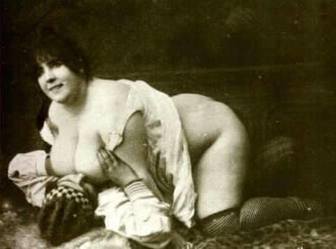 Perhaps it seems odd that there was so much anti-fat sentiment during an era when the queen herself was overweight. Then again, throughout history, extreme weights on either end of the spectrum have always been a subject for criticism and ridicule. This is nothing particularly new; however, using a woman’s weight as a barometer of her intelligence, her character, her sexuality, and even her sanity is something quintessentially Victorian. I’d like to say that we know better now, but even with modern science and education, these negative stereotypes cast a very long shadow. 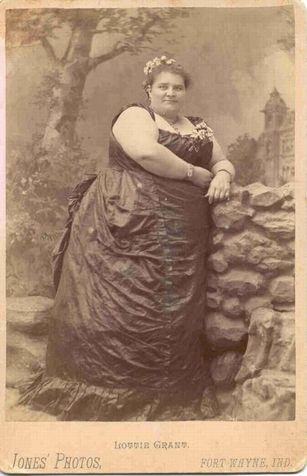 Works Referenced or Cited in this Article Alcohol, Tobacco, and Obesity: Morality, Mortality and the New Public Health. New York: Routledge, 2011. Banting, William. Letter on Corpulence: Addressed to the Public. Volume 13. London: Harrison, 1864. Brinton, Daniel Garrison. Personal Beauty: How to Cultivate and Preserve it in Accordance with the Laws of Health. Springfield: W. J. Holland, 1870. “Fashion and Stout Ladies.” All the Year Round. Vol. X. London, 1893. Fletcher, Ella Adelia. The Woman Beautiful. New York: W. M. Young & Co., 1899. “The Great Danger in Pushing Muscle Power to an Extreme.” The Dietetic and Hygienic Gazette. Vol. XVI. New York, 1900. Lombroso, Cesare. The Female Offender. New York: D. Appleton, 1897. Silver, Anna Krugovoy. Victorian Literature and the Anorexic Body. Cambridge: Cambridge University Press, 2004.
6 Comments
Sybal Janssen
2/9/2017 03:50:14 pm
That's just unfair! I have been overweight, but failed to indulge in promiscuity. I was born too late.
Reply
2/9/2017 05:44:48 pm
People still refer to curvy women as being voluptuous, a word which--at its heart--means someone who indulges in sensual pleasures. It makes me think that, on some level, the connection between weight and sexuality still exists!
Reply
2/10/2017 02:24:56 am
That was fascinating! Amazing how many hangovers from Victorian times we still suffer from. Thanks!
Reply
2/10/2017 02:06:00 pm
You're very welcome, Imelda! Unfortunately, some negative stereotypes from history refuse to die, even when they have long since been disproved by science and common sense.
Reply
Stephen Barker
5/22/2017 11:50:14 pm
Whilst doing some research in a local newspaper from the 1880's I came across an advert for "Allen's Anti Fat Pills"
Reply
5/23/2017 03:56:04 am
Fabulous article. I thought fat shaming started later. It's certainly part of the 20th & 21st centuries.
Reply
Leave a Reply. |
Sex History ContentsIf you would like to submit an article, please fill out a submission on the Contact page Archives
September 2020
|
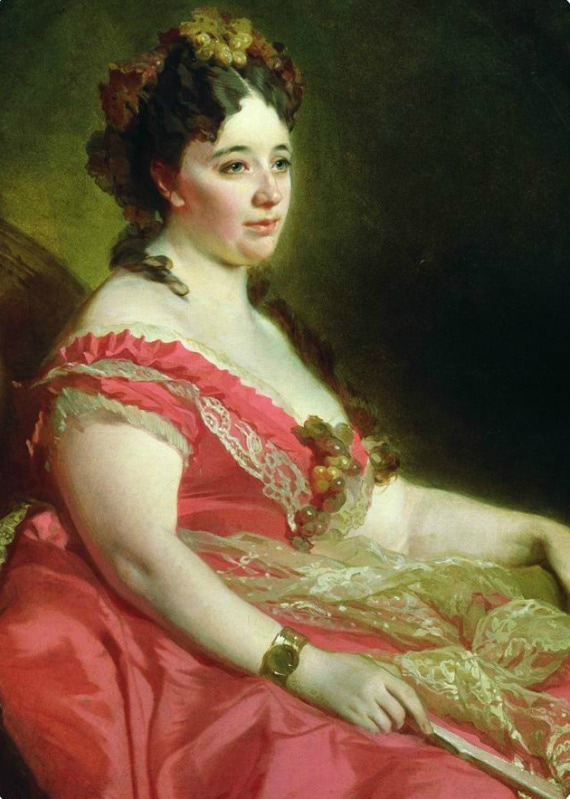
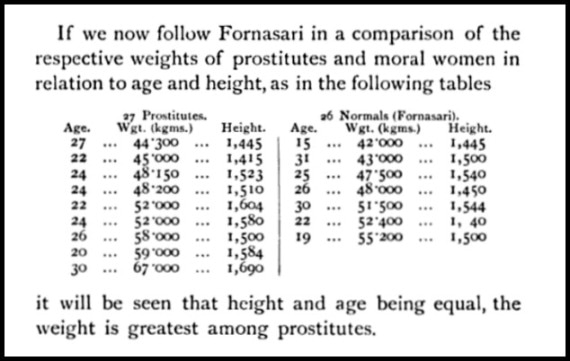
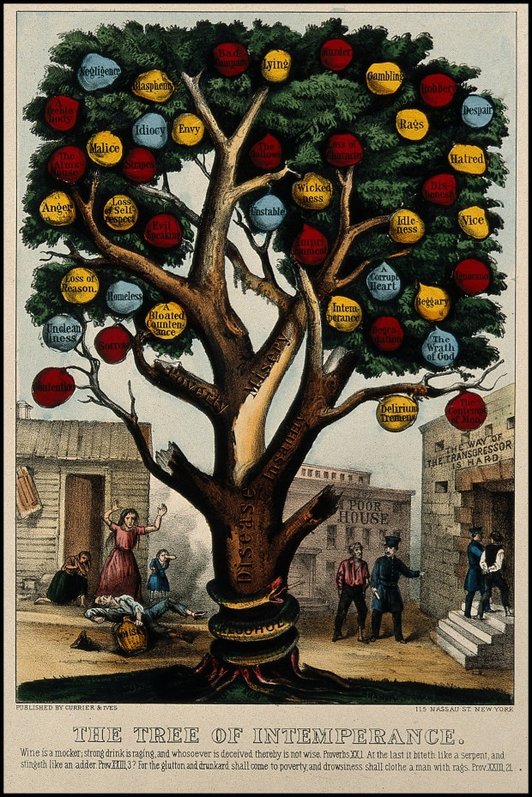
 RSS Feed
RSS Feed